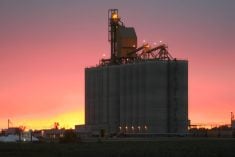FEED THOSE CROPS
Ah, food. We humans love it, can’t get enough of it and have long since passed the point of just eating to live. Well, most of us, I suppose. The topic of a growing obesity epidemic in the face of people still going hungry in North America is a topic for another time and place. In this magazine, when we talk food, it’s usually about plant food, in its many forms, and its functions.
What still trips me up at times, is how we humans eat and eat until we’re soft around the middle and pudgy in the cheeks, but for whatever reason some still figure plants can and will “get by” on what’s already in the ground. Yes, plant life is truly amazing and uses its magic to turn sunlight into energy, but let’s not forget or downplay the importance of feeding the crop. The soil can only supply so much and, over time, becomes depleted.
Read Also

Cancer agency reclassifies another herbicide ‘probably carcinogenic’
The WHO’s cancer research agency has now put atrazine, a herbicide well known to corn growers, in the same potential-hazard category where the agency put glyphosate.
But fertilizer isn’t cheap, and there are often more questions than answers about how much, in what form, where and when to apply it. Part of the answers to those questions is going to be incredibly farm specific, but the key message is that fertilizer is rarely a flat-out cost — it’s an investment.
One other discussion I’ve been having a lot lately involves this idea of moving past front-loading fertilizer. We have the technology, knowledge, equipment and products to get away from fall or spring applications of full rates of fertilizer and can, instead, put down some with the crop at seeding and top it up as the growing season progresses.
The concept of staging crop nutrition (read more on page 10) is partially risk management (if it’s not sitting in the soil, you’re not going to lose it), but it’s also about more efficient use of fertilizer. As many of you experienced in 2010, nitrogen loaded on in the fall was subject to heavy denitrification and leaching losses. Those who didn’t get a crop in had to stand by and watch the weeds eat up those resources… and then promptly killed the suckers, I’m sure.
Of course, the reverse is also true — sometimes having all your nitrogen on in the fall is a good thing, as it’s one less thing to worry about come spring (but look at some specialty N products to save on losses, OK?).
But my thinking on staged nutrition is more focused on better matching input with crop value potential. By applying only a portion of fertility needs at seeding, you can wait and see what Mother Nature throws at you, what your crop looks like and what crop prices are doing into the growing season. If all looks hunky-dory, you’ve got time to follow up with either liquid or foliar applications later in the season. If the crop gets knocked out or drowned out, you haven’t wasted any money on fertilizer for a crop that isn’t worth it.
LET’S TALK ABOUT PHOSPHORUS
In this issue ofGrainewsI decided to take the fertilizer limelight off nitrogen somewhat and talk instead about its sister nutrient, phosphorus. Yes, nitrogen (N) is important and is likely the highest-volume fertility product you’ll apply in a growing season; however, phosphorus is also integral to healthy, vigorous plant growth. It’s also a nutrient that acts quite different to N in the soil and so requires very different management.
First off, phosphorus (P) is not needed in as high a quantity as N. P is mobile in the plant, like N, but is immobile in the soil, making it crucial for fertilizer to go down where the plant can access it early in the season. Because P is immobile in the soil, it also tends to hang around in there awhile and can accumulate over time quite easily. That’s both a good and a bad thing. Good, in that as you’ll read on page 8, having a soil rich in P can save your bacon in years where you may not apply enough (or any at all). The downside: P gets tied up in the soil and the amount released each year is highly dependent on growing conditions. That makes soil P an unreliable source in some ways.
ON-FARM FIELD TRIALS
It’s late January, when winter feels like it’s been here forever and the excitement of the holiday is long past. I hope at least some of you are taking this quiet time on the grain farm to invest in a family vacation (yes, it’s an investment), organize the farm records and develop exciting new plans for the 2011 growing season.
In a recent blog (found at http://bloggn.grainews.ca/lyndsey/), I threw down a challenge of five things to do or change or try on your farm to make 2011 the best one yet. Featured prominently on that list is trying something new in conjunction with a thorough evaluation of the practice. Change for the sake of change makes no sense at all, but doing the same things over and over without assurance of their effectiveness isn’t good business sense either.
Perhaps this is the year to spend a little extra time on planning and record-keeping while you change up one or more practices. For example, trying a new variety, especially if you haven’t in a while, is a great thing, but there’s no need to go overboard. For canola, start with 40 acres, go bigger with cereals, but be sure to have a comparison.
The same goes for fungicides and fertilizer rates or even varying fertilizer rates — don’t just assume you’re gaining yield or saving money. Leave a test strip, keep detailed records and do a comparison during the year and after harvest. You might find that fungicides pay off better than you thought and that your crop could use more fertilizer, or vice versa. But you won’t know unless you compare.
Of course, if you do try an on-farm trial, let me know how it turns out or what sorts of trials you’d like to see in the pages here. My number and email are in that box to the left. Leave a message if I don’t answer.
GET IT IN WRITING
A recent phone call with a farmer friend of mine drove home the importance of written business agreements. Yes, even with your neighbours. In fact, perhaps it’s most important between neighbours. What happened is this: a handshake deal was made between two neighbours. One neighbour would provide lodging and skill for calving out some heifers, while the other neighbour would provide winter feed as payment. All was going fine until a disagreement between the two had one neighbour bringing his heifers home early and the other neighbour short of feed in the middle of January.
Unfortunate? Yes. Avoidable? Absolutely. Whether it’s crop-share rents, custom feeding or any other sort of bartering deal, get it in writing. I don’t care if it’s your neighbour of 20 years or your cousin or your father-in-law. Farming is a business and everyone wins when the basics of any deal and all expectations are laid out on the table ahead of time. Ultimately, it may mean the difference between making a living and dealing with litigation, and a simple written agreement could save a friendship or business relationship. It’s worth whatever initial discomfort hashing out the details might bring. Do yourself a favour and get it in writing.
CHECK MAILBOXES OFTEN
It’s nearly February, and that means nearly-weekly issues of Grainewsfor the next two months. I apologize in advance for the avalanche of paper set to arrive in the mailbox, but, hey, it gives you something to read by the fire (I’m looking at you, Marc Raffard!) and something to look forward to each week.
Stay warm and happy planning for 2011!
Cheers, Lyndsey
———
Wheat &














